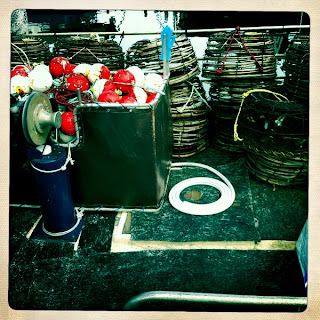WELCOME TO ART SCHOOL AND HAVE A NICE DAY
This is the entrance to the University of Tasmania Centre for the Arts, or as it is more commonly known as "Art School". Now don't be put off by the sea of black and white suits. This photo was actually taken two weeks before today when I popped in to see Olivia Bowman (Sub-Dean) about what units to choose. Five minutes after I arrived the fire alarm went off so I joined the other people in the building at the Emergency Evacuation Point. Turns out theres an obscure area where they house some of the School of Law (those lawyer types like a swanky location). At the time only the Art Staff and a summer school contingent of Law Students were on site. As we all waited for the "all clear" to come back into the building I struck up a conversation with a lovely fellow who I identified as "one of the rainbow family". Anyway we joked about the suits for a bit and then introduced ourselves. Turns out it was Noel the Head of the Art School. Today I bumped into him in the corridor and he asked how I was settling in. Lovely guy.

PHOEBE'S FIRST ART AND DESIGN HISTORY LECTURE
GREEKS TO NAZIS AN INTRO TO CLASSICISM
This is a picture of my first Art History lecture. The subject "Classicism". We covered the Ancient Greeks and their "
Kouros" idealised sexy young man statues all the way to Nazi Germany and Hitlers Classicism revival to emphasise Arian supremacy. The lecturer Dr Liewellyn Negrin defined "Classicism" as harmony between the parts and the whole, symmetry/ order and proportion, man idealised with all imperfections removed. She said that for the Greeks the human figure was divine and that physical perfection equaled moral perfection. Apparently the ancient greeks participated in sport because they believed that physical perfection meant a virtuous or good person. She used the
Discus Thrower as an example of Greek ideals of physical sporting perfection. That somehow perfecting the body would perfect the mind. It made me think about how in Australia today there is so much emphasis on sport and sporting prowess. I thought about the "bad boys" of rugby and AFL and how the reputations of many sporting heros in the media are less than virtuous. When I think of footy players at the peak of their physical appearance I don't think of a morally perfect men, quite the opposite in fact. Perhaps though there is still that expectation that physical perfection means moral perfection. Otherwise why would there be that "hero" and "role-model" expectation placed on high profile sportsmen.
I also thought about how in some ways modern fashion magazine photography is a form of "classicism". Sure the Greeks celebrated the ideal male form as unblemished and symmetrically perfect... but that only makes me think of the skinny, de-feminised, photoshopped female form seen in magazines aimed at both men and women. Apparently the only female character or God commonly carved into stone by the Greeks and Romans was Aphrodite (if you were Greek) / Venus (if you were Roman) The Goddess of Love/Lust but she often appears in what is known as the "
pudica" pose. A pose where the figure attempts to cover up their naughty bits. So while the men of ancient Greece and Rome were proudly flaunting their nether regions the girls were expected to cover up their shameful female bits.
Dr Negrin also touched on Classicism revivals through history such as during the Renascence. See Botticelli's "
Birth of Venus" (1482) - note the pudica pose - and the larger than life Michelangelo's "
David" (1501). She says that the revival of Classicism during the Renascence represented mans belief in himself not as Gods in the form of man. Again it is the male figure that is celebrated. Dr Negrin showed us Michelangelo's "
Tomb of Giuliano De Medici" (1564) to further illustrate how the male form was so revered that Michelangelo couldn't even get the female form right. Check out the masculine looking chick on the left.
She ended with Modern Classism and how Classism got a very bad reputation when Adolf Hitler (weirdly a failed artist himself) got himself all worked up about the Arian ideal and German supremacy. Dr Negrin gave the following examples: "
Relay Runners" (1935, K Albiker, "Discus Thrower " (1940, Bechstein) and the "
Nurenburg Stadium -1937" Albert Speer. Naturally this association with Nazi Germany didn't do Classicism any favours.
Some recent examples of Classism are mostly having a dig at Classism itself. See "
Standing Hooded Figure"(1983 M Castanis) and "It is forbidden to awaken the Gods" (1983 C M Mariani).
and now for something completely different...
THE TOSTER IN THE TOILET
In the women's toilet in sculpture area of Art School there is a toaster on the wall... don't ask me why. I guess some sculpture student was being very clever or something. I got a kick out of it anyway. I was also impressed with the seat covers for hygienic worry free seating on the throne (see seat cover dispenser at rear of toilet). Very civilised indeed.






















